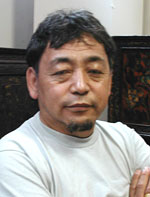Tibetans in Minnesota: Preserving Their Culture
Part of MPR's special report, Ocean of Wisdom: The Dalai Lama's Visit
By Art Hughes
Minnesota Public Radio
May 7, 2001
The Dalai Lama, Tibet's exiled spiritual and political leader, begins a three-week tour of the United States in Minneapolis Tuesday. Nine years after a congressional act to help resettle 1,000 Tibetan refugees in selected locations, the Twin Cities boast the second largest concentration of Tibetans in the country, behind New York. A key concern now among the Tibetan immigrants is how to preserve the strict tenets of their culture and language in a country where religion and politics are kept separate, and spiritual practices are often obscured by material pursuits.
THERE'S NOTHING EXOTIC, OR EVEN REMOTELY FOREIGN,
about Thupten Dadak's home in the middle of a quiet block in a suburb of Minneapolis. But inside, as incense smoke streams past gleaming Buddha statues and hand painted textiles, four Tibetan monks begin chanting, invoking an ancient and distant culture.
Dadak left Tibet when he was five years old in 1959 - the same year the Dalai Lama escaped. When Dadak came to Minnesota with his American wife in 1985, he was one of only two Tibetans in the state. Then Congress made 1,000 visas available to displaced Tibetans, and Minnesota was named a resettlement site. Dadak remembers his exuberance as the first 160 Tibetans began arriving.
"People know my house as Tibet house. I have sometimes 10 or 12 people, and sometimes 30 people, sleeping in my basement. So once in a while I don't know the days are passed. Totally enjoyable. But then you know they have to work and I have to survive - you have to make a living," says Dadak.
Many of the first Tibetan immigrants got two and even three jobs, primarily in the service industry at hotels and hospitals. Most of them became U.S. citizens and were able to bring in their families. But word also spread to the other 20 or so clusters of Tibetan immigrants in the U.S. that the network of support in the Twin Cities is good and jobs are plentiful. Dadak also says the Tibetans' generally reserved nature seems to resonate with what's known here as "Minnesota Nice."
"Tibetans are always not so excited kind of person. Always a little conservative. When I first came to the Twin Cities, people first kind of conservative. But once you know long, their commitment always there," says Dadak.
Nine years after the resettlement project, Minnesota's Tibetan population is now close to 1,000. For the Dalai Lama's visit they're busy constructing butter sculptures, dusting off ceremonial costumes and have even imported a few yaks to invoke their homeland.
But they also find themselves looking for strategies to pass on the soul of their culture. Like Dadak, many of the original immigrants have longing memories of the home country they had to leave to save their own lives. Their kids meanwhile, have an abundance that makes room for $150 athletic shoes and music videos by Destiny's Child.
Roger Jackson, a religion professor at Carleton College in Northfield, has been active with the Tibetan immigrants. He says they always hold out hope they will someday return to a free Tibet. In the meantime, their concern is how to sustain a sense of their community here in the United States.
It shows up in concerns about kids and things that happen to them or don't in the school system. The fear that they could be drawn into gangs for some reason. Fears that there isn't enough infrastructure to support the preservation of the culture around here. They've done remarkable things with no physical locus. But if they were actually able to find a locus for their effort it would be a wonderful thing," says Jackson.
In a neighborhood community center, two dozen high school students are practicing a traditional Tibetan dance they'll perform for the Dalai Lama. At least three-quarters of them - boys and girls - have the first name Tenzin, after the Dalai Lama's taken name. In addition to their high school classes, all of the students study Tibetan language and writing. Chemi Tokar, 18, has lived in Minnesota for only five years. She realizes the links to her culture have a role in her life.
"I like dancing, and we have to be serious because it's not like a joke. I think it comes from my dad because he's a dancer, and he sings and plays drums and I think I get it from him," says Tokar.
Organizers of the Dalai Lama's visit in the Twin Cities say any money left over from ticket sales and donations will go toward building a Tibetan community center - a place where the entire Tibetan population can go to worship and study and dance together. The Dalai Lama is visiting seven U.S. cities in all. His next stop is in Salt Lake City, Utah.
Part of MPR's special report, Ocean of Wisdom: The Dalai Lama's Visit
By Art Hughes
Minnesota Public Radio
May 7, 2001
|
|
RealAudio |
The Dalai Lama, Tibet's exiled spiritual and political leader, begins a three-week tour of the United States in Minneapolis Tuesday. Nine years after a congressional act to help resettle 1,000 Tibetan refugees in selected locations, the Twin Cities boast the second largest concentration of Tibetans in the country, behind New York. A key concern now among the Tibetan immigrants is how to preserve the strict tenets of their culture and language in a country where religion and politics are kept separate, and spiritual practices are often obscured by material pursuits.
| |
|
|
|
||
Dadak left Tibet when he was five years old in 1959 - the same year the Dalai Lama escaped. When Dadak came to Minnesota with his American wife in 1985, he was one of only two Tibetans in the state. Then Congress made 1,000 visas available to displaced Tibetans, and Minnesota was named a resettlement site. Dadak remembers his exuberance as the first 160 Tibetans began arriving.
"People know my house as Tibet house. I have sometimes 10 or 12 people, and sometimes 30 people, sleeping in my basement. So once in a while I don't know the days are passed. Totally enjoyable. But then you know they have to work and I have to survive - you have to make a living," says Dadak.
Many of the first Tibetan immigrants got two and even three jobs, primarily in the service industry at hotels and hospitals. Most of them became U.S. citizens and were able to bring in their families. But word also spread to the other 20 or so clusters of Tibetan immigrants in the U.S. that the network of support in the Twin Cities is good and jobs are plentiful. Dadak also says the Tibetans' generally reserved nature seems to resonate with what's known here as "Minnesota Nice."
"Tibetans are always not so excited kind of person. Always a little conservative. When I first came to the Twin Cities, people first kind of conservative. But once you know long, their commitment always there," says Dadak.
Nine years after the resettlement project, Minnesota's Tibetan population is now close to 1,000. For the Dalai Lama's visit they're busy constructing butter sculptures, dusting off ceremonial costumes and have even imported a few yaks to invoke their homeland.
| |
|
|
|
||
It shows up in concerns about kids and things that happen to them or don't in the school system. The fear that they could be drawn into gangs for some reason. Fears that there isn't enough infrastructure to support the preservation of the culture around here. They've done remarkable things with no physical locus. But if they were actually able to find a locus for their effort it would be a wonderful thing," says Jackson.
In a neighborhood community center, two dozen high school students are practicing a traditional Tibetan dance they'll perform for the Dalai Lama. At least three-quarters of them - boys and girls - have the first name Tenzin, after the Dalai Lama's taken name. In addition to their high school classes, all of the students study Tibetan language and writing. Chemi Tokar, 18, has lived in Minnesota for only five years. She realizes the links to her culture have a role in her life.
"I like dancing, and we have to be serious because it's not like a joke. I think it comes from my dad because he's a dancer, and he sings and plays drums and I think I get it from him," says Tokar.
Organizers of the Dalai Lama's visit in the Twin Cities say any money left over from ticket sales and donations will go toward building a Tibetan community center - a place where the entire Tibetan population can go to worship and study and dance together. The Dalai Lama is visiting seven U.S. cities in all. His next stop is in Salt Lake City, Utah.


